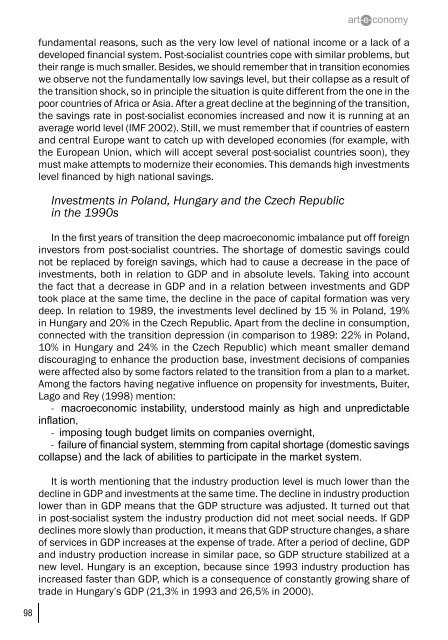art-e-conomy _ reader - marko stamenkovic
art-e-conomy _ reader - marko stamenkovic
art-e-conomy _ reader - marko stamenkovic
Create successful ePaper yourself
Turn your PDF publications into a flip-book with our unique Google optimized e-Paper software.
98<br />
fundamental reasons, such as the very low level of national income or a lack of a<br />
developed financial system. Post-socialist countries cope with similar problems, but<br />
their range is much smaller. Besides, we should remember that in transition economies<br />
we observe not the fundamentally low savings level, but their collapse as a result of<br />
the transition shock, so in principle the situation is quite different from the one in the<br />
poor countries of Africa or Asia. After a great decline at the beginning of the transition,<br />
the savings rate in post-socialist economies increased and now it is running at an<br />
average world level (IMF 2002). Still, we must remember that if countries of eastern<br />
and central Europe want to catch up with developed economies (for example, with<br />
the European Union, which will accept several post-socialist countries soon), they<br />
must make attempts to modernize their economies. This demands high investments<br />
level financed by high national savings.<br />
Investments in Poland, Hungary and the Czech Republic<br />
in the 1990s<br />
In the first years of transition the deep macroeconomic imbalance put off foreign<br />
investors from post-socialist countries. The shortage of domestic savings could<br />
not be replaced by foreign savings, which had to cause a decrease in the pace of<br />
investments, both in relation to GDP and in absolute levels. Taking into account<br />
the fact that a decrease in GDP and in a relation between investments and GDP<br />
took place at the same time, the decline in the pace of capital formation was very<br />
deep. In relation to 1989, the investments level declined by 15 % in Poland, 19%<br />
in Hungary and 20% in the Czech Republic. Ap<strong>art</strong> from the decline in consumption,<br />
connected with the transition depression (in comparison to 1989: 22% in Poland,<br />
10% in Hungary and 24% in the Czech Republic) which meant smaller demand<br />
discouraging to enhance the production base, investment decisions of companies<br />
were affected also by some factors related to the transition from a plan to a market.<br />
Among the factors having negative influence on propensity for investments, Buiter,<br />
Lago and Rey (1998) mention:<br />
- macroeconomic instability, understood mainly as high and unpredictable<br />
inflation,<br />
- imposing tough budget limits on companies overnight,<br />
- failure of financial system, stemming from capital shortage (domestic savings<br />
collapse) and the lack of abilities to p<strong>art</strong>icipate in the market system.<br />
It is worth mentioning that the industry production level is much lower than the<br />
decline in GDP and investments at the same time. The decline in industry production<br />
lower than in GDP means that the GDP structure was adjusted. It turned out that<br />
in post-socialist system the industry production did not meet social needs. If GDP<br />
declines more slowly than production, it means that GDP structure changes, a share<br />
of services in GDP increases at the expense of trade. After a period of decline, GDP<br />
and industry production increase in similar pace, so GDP structure stabilized at a<br />
new level. Hungary is an exception, because since 1993 industry production has<br />
increased faster than GDP, which is a consequence of constantly growing share of<br />
trade in Hungary’s GDP (21,3% in 1993 and 26,5% in 2000).


